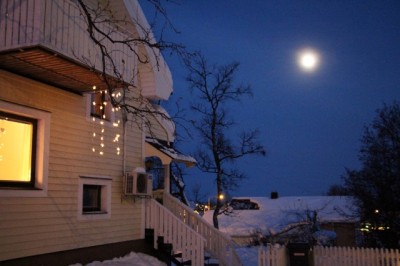It was day three of no daylight in Kiruna. ‘What, now?’ our guests protested, noticing light through the window. I’d been explaining that ‘no daylight’ means no sun above the horizon but it doesn’t mean total darkness – just long, soft, lingering twilight hours surrounded by a thick crust of dense black.
Still, it’s enough to make one SAD, reading in the papers how many people suffer from this (Seasonal Affective Disorder). Down at 50 degrees latitude people suffer very badly from lack of daylight and are desperately popping vitamin D3 and buying up light boxes just to stay alive. And yet here at 68 degrees life goes on as normal, only darker. I haven’t noticed an outbreak of SAD, and I’ve nothing of that kind to report myself.
Why would this be? You can explain a bit by saying, well we have lots of snow up here so everything looks so much more cheerful, and the snow reflects and creates more light. But you can’t get round the simple facts: Kiruna zero hours daylight, Stockholm 6 hours, London 8 hours. Now if SAD really is about lack of daylight in Kiruna by now we ought to be suicidal.
The truth is, I like it when it gets dark. I feel a calm descend around me, permission to look inwards, a reason to sit quietly in a private space and be content with the small pleasures of life – music, candles, food, conversation. I know it won’t be forever. The darkness is given to us for a small space of time – only a month – and is an expected part of the rhythm of the year.
Our cities are year-round cities, protected environments with shopping areas the same in any weather and at any time of the year, and houses kept at the same temperature regardless of the season. We can be sitting outside cafés with overhead heating in November and believe it’s really May. We can cross town in January without a jacket, keeping near arcades and hopping on public transport. Throw a bit of climate change into the mixture and the seasons really are hard to notice. Except that, if you spend any time beyond electric light, and you live away from the equator, you will notice decreasing daylight, and there’s nothing at all you can do to disguise that. This can be a blow, if you have an expectation of the year-round city.
It’s easier to accept the darkness here, where it’s so extreme – and I think that’s why we don’t have SAD. Our expectations are met, not confounded.
Today, on the third official day of no daylight, I walked into town in the middle of the day. I wanted to enjoy the glow of the soft, monochromatic twilight, before returning home in the blackness to coffee and cake. I noticed that the street looked more colourful than usual. There was a pillar of reflected sunlight shooting up from the southern horizon. As I got to the top of the hill there was no mistaking the bright orange hub of the sun clearly visible above the horizon, and it was not supposed to be there.
I felt cheated. Disappointed. Sad even. I realised it was visible because it was at its highest point and I was up a hill. I must say, as it sank back below the horizon after only a few minutes I felt some relief. Any more of that and I would have to go out and buy a dark box.


